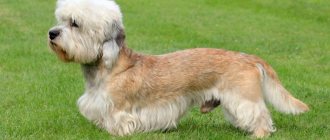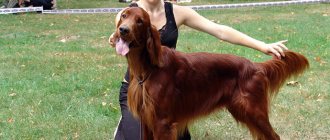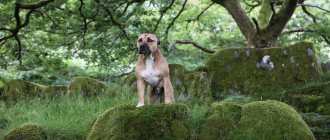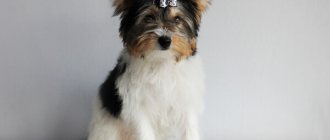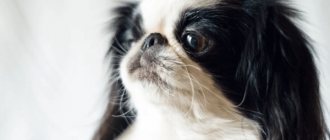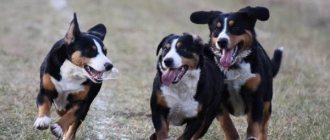Video
* We invite you to watch a video about the Irish Terrier . In fact, in front of you is a playlist in which you can select and watch any of 20 videos about a given dog breed by simply clicking on the button in the upper right corner of the window. In addition, the material contains quite a lot of photos. By looking at them you can find out what an Irish Terrier looks like.
In this article:
|
Rate the material!
[Total votes: 0 Average: 0]
History of the origin of Irish terriers
The terrier group has many varieties of dogs. Irish Terriers are one of the oldest breeds of the group. The ancestors of these animals were most likely black and tan and wheaten terriers. The Black and Tan Terrier is now extinct. The breed was actively developing long before its official introduction. For many years these dogs lived next to people.
Irish terriers guarded people's homes, took part in hunting, or served farmers. Since ancient times, they have been considered universal household helpers. The breed was officially introduced only in 1875. The dog was brought to a dog show that took place in Scotland. The dog made an indelible impression on British and Scottish dog breeders, who recognized the new breed.
After their official recognition, Irish dogs quickly became popular. Within five years they were the fourth most popular dog breed in the UK. In 1881, America recognized the breed. There the dog also quickly gained “fans”. Americans were able to appreciate the efficient, obedient and graceful terrier.
The peak of the breed's popularity was 1889. At the same time, the dog became involved in a big scandal related to the need to crop his ears. Terrier owners were able to achieve a ban on ear cropping not only for their Irish terriers, but also for dogs of other breeds. During the war years, these terriers were of great benefit. They searched for the wounded and delivered various packages.
Origin
The beginning of the history of the breed is difficult to trace, since no written mentions of the terrier have reached our time. The “Irish” are considered one of the oldest representatives of the canine world that existed at the beginning of our era, but this information has not been proven.
The development of the breed began in the 19th century, when an exhibition with the participation of Irish terriers took place in Glasgow in 1875. A year later, the pets went to a similar event in Brighton.
In 1879, a club for “Irishman” lovers was created in Dublin, which contributed to the animal’s popularity among breeders. The first terriers did not have such outstanding external characteristics as today's pets. They had a too massive, completely unathletic body, a voluminous muzzle, and undocked tail and ears. Nevertheless, the pets were recognized by the British Kennel Club at the end of the 19th century.
The dogs became very popular during the First World War, where they worked as messengers, assisted orderlies and searched for mines. In difficult war conditions, Irish terriers did not lose their composure and maintained their restraint, which made them stand out from other dogs.
At the beginning of the 30s. the popularity of animals was at zero: it became difficult to find a purebred representative of the breed. The number of puppies in European nurseries has greatly decreased, so the animals are approaching degradation. To save dogs from extinction, an exhibition was organized in the department store pavilion by businessman Gordon Selfridge in 1933.
On the territory of Russia, the first female Irish terrier appeared at the end of the 40s. XX century. While they were looking for a suitable male, she was bred to a Kerry Blue Terrier and a Welsh Fox Terrier. A nursery from Poland helped with the search, which in the late 50s. transferred several males to the USSR.
Later, a representative of the Irish breed was bred with pets from the GDR. Despite the infusion of fresh blood into the domestic livestock, international rings did not recognize Soviet dogs.
The matter was corrected in 1997, when several British animals were brought to Russia, the heirs of which acquired a sophisticated exterior and received the right to perform on the international stage.
Irish Terrier - description of the breed
Irish Terriers have an attractive, bright appearance.
They are characterized by:
- Muscular torso;
- Long legs;
- Coarse wool;
- Strong jaws.
These terriers are often called natural hard workers. These are healthy and strong dogs with very developed muscles throughout the body. The physique is proportional and harmonious. This dog has a medium-sized body, long legs, a strong back and a flat loin. The chest volume is small, but outwardly this part of the body looks deep and strong. In general, the appearance of the animal is very athletic.
The height of this terrier is about forty-five centimeters. Weight rarely exceeds thirteen kilograms. The Irishman's limbs are very refined. They are slender, but not fragile. Legs are muscular and strong. The hind limbs are larger in size than the front ones. Terrier paws are small and round in shape. This dog's toes are slightly curved, its claws are strong and painted black.
The tail of Irish Terriers is often docked, despite the ban. The tail is docked by about 1/3. The undocked tail is quite long and set high. It should not form a sharp bend. The skull of this terrier is flat and long. It tapers towards the muzzle. Cheekbones are weakly expressed. The neck is quite long, on its sides there are folds and frills made of wool. They reach the bottom line of the skull.
Irish dogs have a strong jaw. They have an excellent grip, so the animals often participate in the process of hunting wild animals. The teeth of the representatives of the breed are healthy and painted white. The Irishman's eyes are small and dark in color. If a yellowish color of the iris is present, then the dog is considered a defective breed. The ears are triangular in shape and tiny in size. The dog's nose is black.
Popular colors of Irish terriers
A special feature of the Irish Terrier breed is its very hard coat. It lies flat on the animal’s body, in some places with a characteristic break. The hairs grow very thickly and completely cover the dog's skin. According to the standard, the wool should be of medium size. It should not hide the silhouette, be very curly or too long. The hair on the head should be shorter than in other places.
Nature has awarded Irish Terriers with a beautiful red coat color. The coat should be exclusively red, but a variety of shades of this color are allowed: from copper to wheat. Yellow-red color is also considered acceptable. All other colors, shades, marks must be absent. With them, the dog will be disqualified from any dog show or competition.
The exception is white tan markings, which may be placed on the chest. The same stains in other places are undesirable. The color of the Irish Terrier's coat should be uniform, and the coat itself may feel like thin copper wire to the touch. This dog sheds moderately if the animal is brushed daily during this period. Such coarse fur needs to be combed out with a special thick brush.
The Irish Terrier's coat is unique. It not only has a very beautiful, uniform red color, but also performs a practical function. It can be compared to chain mail. Hard and thick hair protects the animal’s body from various injuries. Thanks to this coat, the dog almost never has scratches or wounds on the skin. In addition, thick wool repels water and dirt.
Description of appearance and standard
The Irishman is of medium size, height at the withers is from 35 to 47 cm, males weigh up to 15 kg, females are noticeably lighter - up to 13 kg.
- Energetic, cheerful and friendly - the red terrier is always in a good mood. According to the standard established by the Canine Federation, it must be fiery red in appearance.
- The head and muzzle are elongated, the forehead is of medium length, not significantly tapering towards the nose. A prerequisite is complete coloring of the nose. He has wide nostrils and a funny mustache, like a goatee on his chin. Lips are fully colored and fit tightly to the jaw.
- Jaw: not large, but strong. Bite – regular, pincer-shaped, full set of teeth, medium-sized canines.
- Eyes: round, not large – dark color. Visually pronounced brow ridges and fur forming, protruding, long eyebrows. Planted fairly close, not particularly deep. The look is expressive.
- Ears: set high on the head, triangle shaped, facing forward. The cartilage is quite tough. Outer triangle, whistling parallel to the muzzle, forming even angles with the cheekbone. Their fur is smoother and shorter.
- Neck: strong, of medium size, proportional, there is a semblance of a woolly mane, but not of an elongated type. Good muscles, mostly dry in nature.
- Chest: not large, oval shaped, not particularly prominent, with good muscles.
- Back: Mostly straight, not elongated, well muscled.
- Body, body: good bones, not heavy. A compact, lean body with well-developed muscles looks elegant. The shoulder is not short, which allows you to develop greater speed in movement.
- Tail: high set, curled into a bagel, lying on the back. Saber-shaped, can be docked by 1/4 of its entire length.
- Paws, limbs: medium long, proportional, with good muscles, straight. The hind legs are larger and stronger, the hip is wide and powerful. The paws are round, compressed into a tight ball, the nails are strong, the color is black. A prerequisite is the absence of inversion of the elbow, which looks exclusively back. The hock joint is located low enough that it can be visually seen immediately.
Externally, the animal is light, residually muscular, but without any burden. Movements are free and fast. By nature a hunter who can easily catch up with both large predators and small rodents. With such a compact size, he can easily climb into a hole and try to pull out, for example, a hare on his own.
Wool
The coat is predominantly of a hard type, the sun dog is hard to the touch, the hair is straight, the undercoat is well developed. Dense, thick and without the ability to curl, it practically does not absorb water.
- On the head and ears, slightly shorter, they have a characteristic mustache and beard, as well as eyebrows.
The color is exclusively fiery red, almost red. Red Terriers may have slight shades of coat, but the standard should only be a fiery red color.
Character and habits of Irish terriers
Irish Terrier dogs have a cheerful character. These animals are almost always in a good mood. They happily support any idea of their owner. They can become real hunting assistants or simply keep company while walking near a pond. These puppies have innate hunting skills: they achieve high results both on land and in swamps.
Also, the character of this dog can be called independent. From birth, terriers are quite willful, brave and smart. They are true leaders by nature. Sometimes dogs try to take leadership positions in their human family. To prevent this from happening, the Irishman should be trained from puppyhood. He needs to make it clear who is in charge in the family and then there will be no problems.
Irish Terriers are very loyal pets. They will never betray their master and family; they will treat them with respect and great love. However, this dog's friendship must be earned. When walking, terriers love active activities, running. Often these dogs begin to conflict with others. This is due to the same leadership. The Irishman will always strive to demonstrate his superiority.
As already noted, an Irish Terrier needs to be trained from puppyhood. It is important to remember that these dogs do not accept aggression and rudeness. Parenting should be friendly but persistent. If you show rudeness, the terrier will cease to respect its owner and may begin to cause mischief at home. And severe physical punishment can cause rage and aggression in a dog, which is fraught with consequences.
Character
Most of the time, the Irish Terrier is active, active and playful. But representatives of the breed are subject to sudden mood swings.
He does not show groundless aggression, is resistant to stress, and his behavior is adequate. But in order for a terrier to be obedient, loyal and meet the above characteristics, the owner must raise him correctly.
The Irish treat all family members equally. It is not in his nature to highlight the main thing. He is especially good with children.
He is ready to play with kids all day long, simultaneously playing the role of a play partner and a vigilant guard.
The main character traits of the Irish Terrier are kindness, responsiveness, and cheerfulness. He is able to quickly make friends with a stranger and start a game with him. But this does not mean that the dog cannot serve as a watchman.
If you attack the terrier or give reason to doubt his good intentions, he will fearlessly rush to defend his territory and protect his owners and their property.
He gets along with other dogs and pets, but, again, if there is no aggression on their part. There will never be rats or mice in the house and yard where the Irish Terrier is kept.
The instinct of a hunter for rodents and other small game is developed in the blood of representatives of the breed from birth. It follows from this that it is not recommended to keep a terrier and, for example, a ferret, a decorative rat, a rabbit, etc. in the same house.
Interesting facts about Irish Terriers
Irish terriers have been serving and helping people in various spheres of life for centuries. These dogs were of great benefit even during wars. Thus, during the First World War, these terriers were part of the British army. They bravely overcame all military difficulties along with people, sometimes saving the lives of soldiers and quickly conveying important messages. In Britain, these dogs are considered real heroes.
Irish Terriers have a unique coat. It protects dogs from scratches and injuries, provides warmth at low temperatures, and holds water well. It is thick and has hair that is hard to the touch. Another feature of the coat is the absence of undercoat. For this reason, animals practically do not shed. Due to the lack of shedding, some people with allergies can safely keep such a pet at home.
In their homeland, Irish terriers performed many different functions: guarding houses and farmland, helping shepherds and hunters. But the most interesting thing is that they also took on the cat function. These dogs successfully caught rats and mice. They have impeccable hearing and a good sense of smell. Thanks to the efforts of the terriers, it was possible to save the harvest and food that had been spoiled by mice.
The Irish Terrier breed has many unique qualities. One of them is their signature stand. These dogs are known to many hunters precisely because of it. The dog takes a characteristic stance during a hunt when it notices a wild animal nearby. The Irish Terrier, having noticed the target, almost instantly stretches out like a string and freezes in this position for several seconds. It looks very unusual.
Training and education
If the Irish Terrier is not trained, if you do not go through at least a general training course with him, the dog will ignore any commands from the owner and will become uncontrollable, which will definitely lead to many maintenance problems.
Education must be consistent. No rudeness or physical punishment. Plan your lessons so that the terrier does not get bored during training.
Use an active, playful form. Sedentary training can get boring for your pet, and as a result, you will have to wait longer for a positive training result.
It is not recommended to learn several new commands during one lesson. One lesson - one team. The lesson should consist of three parts: learning new things, repeating old things, and playing using learned commands.
Interesting Facts
- Dirt does not stick to the Irish Terrier's coat.
- Irish Terriers were used as messengers during the First World War.
- A terrier served on the Canadian destroyer, which could detect a hostile submarine, while it could not be detected even on the ship's instruments. Having sensed the enemy, the dog immediately gave a signal with a ringing bark.
- In his stories, Jack London more than once gave one of the main roles to the Irish terrier.
- The Irishman is called the gentleman's chosen one and the farmer's best friend.
Pros and cons of Irish Terriers
The undeniable advantages of the breed are:
- Playfulness, activity;
- High level of intelligence, easy learning;
- Versatility;
- Bright appearance.
These dogs have become favorites among many dog breeders due to their easy-going, kind disposition. Irish terriers are always playful, have a good mood and can support any initiative of the owner: be it a walk in the forest or a hike in the mountains. Terriers love to walk, run, and swim. Every walk is like a holiday for them (especially for those who live in an apartment). They are practically tireless if they are healthy and fed.
During walks, the dog likes to spend time usefully. These dogs love to learn some new skills and commands. Part of the walk should definitely be devoted to training. Training Irish Terriers is a pleasure, because they are very smart animals. They quickly grasp the material. The most important thing is to follow one rule - do not use harsh punishments or aggressive methods of education.
Versatility is undoubtedly a positive quality of this dog breed. Irish terriers can be not only companions, but also guards or assistants during the hunt. They bring a lot of benefits. In addition, this breed is very aesthetically attractive. The Irish have a bright red color, a muscular body and an unusually thick coat. Such a pet attracts the glances of passers-by.
The disadvantages of the breed include short temper. The Irish Terrier may often conflict with other dogs during walks or claim leadership in the family. These disadvantages can only be corrected through early and correct education. Another disadvantage is the constant need for physical activity. It is important for your dog to maintain his athletic form.
How to choose a puppy
The choice of a baby is complicated by the fact that in Russia there are few nurseries that officially carry out breeding work. Usually a dog breeder can get a dog when he is 2-2.5 months old.
To choose the animal you like, it is better to get to know it at 1 month. During these visits, you should look at the mother’s reaction: if she tries to gather her heirs into a group and protect them, this is normal, but cowardice or aggression indicate mental abnormalities that can be passed on to the baby.
The dog breeder also needs to look at the reaction of the puppies: they should not try to run away, which may indicate poor socialization. A normal puppy should be sociable, respond well to affection, and strive to communicate. It is best to buy a future exhibitor at 5 months, when you can assess his exterior potential. The price of puppies is:
| Puppy cost | |
| Pets | From 20,000 rub. |
| Heirs of Champions | 30,000 – 40,000 rub. |
| No pedigree | 10,000 – 15,000 rub. |
Breeding Irish Terriers
Irish Terriers are a popular dog breed. The demand for such puppies is always high, so breeding Irish is profitable from an economic point of view. However, it is worth considering other aspects of this activity. Breeding purebred dogs is a costly undertaking that requires physical effort, certain knowledge and conditions. If it is not possible to provide all of the above, then it is better to abandon this idea.
Irish terriers are capricious and conflict-ridden dogs. It will be quite difficult to find a male for a female. She won't let everyone get close to her. Therefore, you will have to have several gentlemen in reserve. Otherwise, the process of selecting a male dog is unremarkable. The dog must be healthy and have vaccination records. It is also advisable that the dog undergo tests immediately before mating.
Good pedigree is another important criterion. If the manufacturer has famous terriers in his family, this will significantly increase the cost of future puppies. An important criterion is the absence of any deviations from the standard or genetic diseases. You need to know the breed standard by heart in order to more easily and quickly determine the disadvantages of potential fathers of future offspring.
Having chosen a male dog, you can organize a meeting. The meeting will be more successful if it is organized on the territory of the dog. Dogs must be in a good mood. There should be no strangers in the room where the mating will take place. One of the hosts may be present. A few days after the first meeting, it is better to repeat the mating. This will increase the likelihood of pregnancy.
History of the breed
Irish terriers are a mystery dog, which, unfortunately, did not leave accurate evidence of its appearance.
Today, there are many guesses and unconfirmed facts that have differences. Each story is unique in its own way; the Irish are confident that the dog appeared long before the return of the country to St. Patrick, who is its patron even now.
There has been an official mention, confirmed by documents, since the middle of the 19th century. The English terriers that came to Ireland presumably became the ancestors of the “little devil”. They were representatives of hunting dogs.
- Before 1870, many ancient counties boasted different varieties of the animal, which in turn had differences in color and height. In each specific area of the country, there were predominantly certain individuals with different colors. So in the north there were brown dogs, and in another county there were black, white and red.
The characteristics of the standard and the official description of the breed were formed only in 1879, at the same moment clubs for Irish lovers began to emerge, the first of which was opened in Dublin and approved the standard for the dog.
The growing popularity subsided in the 20s, to which one of the main lovers of the breed, Earl Selfridge, responded with a major presentation of his dogs in a large shopping center.
Many decided to buy him as a pet, and the Russian ruler Alexander did not stand aside, who was presented with the little devil. He, sincerely amazed by his mischievous character, always took his pet hunting and admired his service qualities.
Irish Terrier Diet
Irish Terriers are always in a state of activity. They spend a lot of energy, so the diet should be as balanced as possible. You can make the task of creating a diet easier for yourself by purchasing industrial feed. Modern high-class feeds contain all the necessary elements. When feeding this food, you do not need to give additional vitamins.
You can select ready-made food with the help of a veterinarian. This is an ideal option, because the doctor will take into account the individual characteristics of your dog when choosing. If you wish, you can feed your Irish Terrier regular foods. However, here you will have to work harder, because the pet’s diet must be compiled correctly so that the animal does not have a shortage of certain elements. The main diet, as for many other breeds, should be protein.
Protein sources can be:
- Meat;
- By-products;
- Fish;
- Dairy products.
It is better to choose lean meat. It could be chicken, turkey, veal or beef. The fish must be sea fish and have no bones. You can season offal and meat with cereals. Buckwheat, rice, and wheat porridge will benefit the Irish Terrier. Ryazhenka, cottage cheese, and low-fat sour cream are also good sources of protein. Fermented milk products must be fresh.
You can include vegetables in your pet’s diet with protein. The dog will eat both fresh and stewed vegetables. The Irish Terrier will not refuse fruits and fresh herbs. In addition to regular products, you need to purchase special vitamin complexes. They should be chosen together with your veterinarian. Smoked meats, sweets, and flour products should not be included in the Irish Terrier's diet.
Diseases and health problems
Irish Terriers are one of the strongest, healthiest dog breeds. In most cases, these dogs do not have genetic pathologies and rarely develop other ailments. However, there are still several diseases that can be diagnosed in your pet. Thus, hyperkeratosis of the paw pads is the most common. This is a breed disease. These dogs have growths on their paw pads.
Hyperkeratosis of the paw pads does not occur often, because for the birth of such puppies, the condition must be met - the presence of a breed disease in both parents. Hip dysplasia is also sometimes found among dogs of this breed. To exclude the possibility of dysplasia, you need to carefully study the pedigree of the female and male before mating. Otherwise, the Irishman’s joints are healthy.
A little less often, various diseases of the eyes, heart, and thyroid gland are detected in dogs. Many of them are curable, others require constant monitoring and prevention. Even less often, representatives of the breed get cancer. The most common diagnosis is melanoma. Naming the exact cause of cancer in the Irish is problematic. However, this is undoubtedly influenced by poor ecology and poor quality nutrition.
Allergies are another ailment that the Irish Terrier may suffer from. An allergy can be to any of the factors: product, smell, care product or medication. It is almost impossible to cure allergies. But you can completely stop its manifestations by eliminating the irritating factor. In general, the Irish are strong, hardy, long-lived dogs. They live for about sixteen years.
Care and maintenance
The Irish Terrier is an unpretentious dog. Its fur is covered with fat. This gives the animal's hair water-repellent and anti-dirt properties. To prevent the protective sebaceous membrane from being washed off, it is recommended to wash the Irishman infrequently. No lumps or pellets form on the dog's fur. She practically doesn't shed. Therefore, hair care involves trimming about twice a year. You can trim your dog at home or in a specialized pet grooming salon. Grooming or a professional haircut is performed on the pet if it is a show dog. In other cases, the dog does not even require combing.
It is imperative to take care of your pet's ears and teeth. Additionally, the nails should be trimmed (about 2 times a month). If the hair between the paw pads has grown long enough, it can be cut off. In order for the dog to splash out its reserves of energy, you need to walk it every day and load it with physical training. The pet needs constant movement, which is why it is absolutely not suitable for a person who loves peace and quiet.
Feeding
The Irishman is very active. His diet should be rich in minerals and vitamins. All microelements must be given in accordance with the age of the dog. The following natural products must be present in the diet:
- meat;
- offal;
- sea fish;
- boiled cereals;
- steamed vegetables.
You should not give your pet store-bought semi-finished products or sausages. There is no need to pamper your dog with sweets and baked goods - you can quickly get used to such food, and this is fraught with unpleasant consequences.
Due to a predisposition to allergies, a dog may not accept dry food well. Therefore, it is necessary to choose commercially produced food taking into account the dog’s age and underlying diseases. An adult terrier should be fed 2 times a day. Uneaten food must be removed. But fresh drinking water should always be available in the access area.
Health and life expectancy
Dogs of Irish origin have excellent health. Hereditary diseases are alien to them. The musculoskeletal system works without any problems. Joint diseases, deformation of bone tissue, and pathology of muscle fibers are practically not found in dogs. In rare cases, Irish people are diagnosed with hip dysplasia. Due to the deteriorating environmental situation in the world, dogs are increasingly susceptible to melanoma and allergic reactions.
The average life expectancy of an Irish Terrier is 11-13 years. However, some individuals easily live up to their 16th birthday. In order for a pet to live a long and happy life, by its own standards, it must be vaccinated. The vaccination schedule must be strictly followed.



